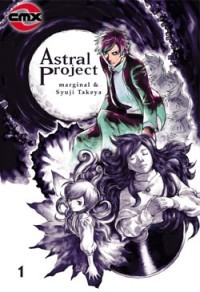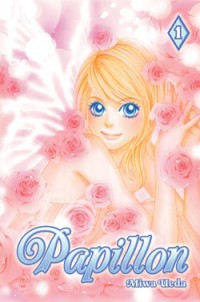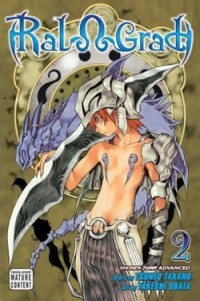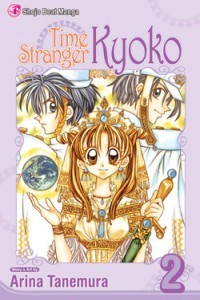RIGHT TURN ONLY!!
Blue Dragon Quest
by Carlo Santos,

Somehow, in between all the new anime I'm covering for the Fall Preview Guide, I still wrote this. And for those of you who are also following the fall previews, there's a special surprise for you: just scroll straight down to the Import of the Month. Do not pass Go! Do not collect $200!
ASTRAL PROJECT

Vol. 1
(by marginal and Syuji Takeya, CMX, $12.99)
FROM THE BACK COVER:
"Masahiko is estranged from his family and lives a dead end existence in Tokyo, working a shady job to pay the bills. When his sister dies under mysterious circumstances, he inherits an unlabeled CD from her possessions. As he listens to the avant-garde jazz music it contains, he is propelled into an out-of-body experience—an experience he soon discovers that he can repeat whenever he wishes. Masahiko's investigation into her death and the source of the CD takes him to both the higher level of the astral plane and the lower depths of the Tokyo underworld."
EVIDENCE FOR:
If the summary of this sounds like yet another "boy discovers amazing supernatural powers" story, don't be fooled—this is more mystery than it is supernatural, and Masahiko's mind trips are simply the vehicle through which he investigates his sister's death. Like the best mysteries, it offers just enough information to make you want to figure it out, but leaves the answers tantalizingly out of reach. Various story elements also reflect a moody, noir-ish world: avant-garde jazz, new age cults, seedy escort services ... basically the other side of Tokyo, after hours. And as for the characters Masahiko meets, they're just as fascinating and mysterious as the out-of-body experiences he's been having—a wise old homeless guy, a flighty girl who works at a convenience store, and the one who might have the clues to it all: a former friend of his sister. A dark and heavy visual style, loaded with black-and-white contrast and plenty of shading, sets the mood perfectly—especially with the trippy out-of-body scenes. With so many supernatural-themed works out there, it's a real treat when one of them turns out good.
EVIDENCE AGAINST:
If this is so moody and sophisticated, why does the main character only have one expression? It seems that someone was trying a little too hard for the manly badass seinen look with this. And it's not just in the face—Masahiko's emotional detachment makes him a difficult character to "get into," especially the way he acts at his sister's funeral and how he relates to that friend of hers. (Then again, the writer also worked on Oldboy under a different name, so in that respect the lead character makes sense.) What's more, throwing out assorted mysterious ideas (here's the name of an obscure jazz musician!) in hopes of luring the reader in starts to backfire once you realize you've got multiple threads of plot with no specific direction. We all want to know how Masahiko's sister's death and cursed CDs and astral projection all connect, but prospective readers might just throw up their hands in frustration if they don't get a clearer roadmap of where things are headed.
FINAL VERDICT:
Truth is, I'm a sucker for the dark and brooding kind of manga if it also makes you think. And with Astral Project being one of those varieties, it's a certified A-.
KYO KARA MAOH!

Vol. 1
(by Tomo Takabayashi and Temari Matsumoto, Tokyopop, $9.99)
FROM THE BACK COVER:
"Yuri Shibuya just can't catch a break. First, he had his head dunked in a toilet. Then he was transported to another world—where he finds himself king of the Mazoku, a new race that expects him to lead them to war against all of humanity. And to top it all off, he's engaged—to a man!"
EVIDENCE FOR:
I suppose I could insert the standard boilerplate about how fantasy tales offer the joy of discovery and watching a new world unfold around the main character. But where Maoh really succeeds is in how utterly loopy it is—there just isn't another fantasy world built like this one, where interdimensional travel happens through toilets and a slap to the cheek is considered a proposal of marriage. Even the characters get in on the loopiness: take Günter, for example, who's supposed to be the court magician/retainer or something, except he acts more like the resident fanboy, gushing endlessly over Yuri's supposedly noble features. Speaking of noble features, it has not escaped Yuri's notice that all the gentlemen of the royal court are unusually attractive ... Call it fangirl-bait if you must, but the campiness is done with a knowing wink and nod—this is a complete bishounen sausage fest, they're saying, and that's why it's completely silly and you're going to like it. Of course, with Matsumoto's delicate, attractive illustrations and efficient sense of layout, how can anyone with an eye for pretty boys not like it?
EVIDENCE AGAINST:
In addition, please also insert the standard boilerplate about how the first volumes of fantasy tales are never the best ones. In establishing the bizarre, quirky world of the Mazoku, it seems that logic and order have gone out the window—at times this feels more a collection of wacky medieval gags than the properly built tale of a boy who would be king. Oh hey, let's have a totally ridiculous custom for propsing marriage! Oh, and all the nobles can wear really embarrassing underwear! A shirtless sumo match is fine too! Look, you're welcome to make up all the crazy ideas you want, but at some point they really ought to be strung together to make up a proper story. Only in the closing strands of the final chapter does it look like an actual storyline is taking place—something about a human-demon conflict—but that's still a long way from the depth and immersiveness that the best fantasy epics are supposed to have. Now that it's proven itself as a comedy, when's the adventure going to show up?
FINAL VERDICT:
Entertaining enough as an introduction, although it still has to work on the story development. Adventure, magic and comedy come together to form a B-.
PAPILLON

Vol. 1
(by Miwa Ueda, Del Rey, $10.95)
FROM THE BACK COVER:
"It's no fun being a high school outcast. It's even harder when your older sister is the most popular girl in school! The ultra-glam Hana is the ultimate teen queen, but her little sister, Ageha, is just a shy tomboy. Hana loves being the center of attention so much she'll do anything to keep her little sister in her shadow. But Ageha has a plan that will change her life. Because no one, not even Hana, can hold Ageha back forever..."
EVIDENCE FOR:
Shoujo romance manga-ka could learn a thing or three from Miwa Ueda: how to create instantly appealing characters, how to set up clearly defined conflicts between them, how to make the artwork flow smoothly from panel to panel—simply put, Ueda has the fundamentals down cold. And it is these fundamentals that make Papillon so much fun to read: Ageha is the classic romantic underdog everyone roots for, Hana plays the manipulative villain we all love to hate, and the competition between them for the boy of Ageha's dreams is intense enough to match any of those "Rawrrr I have more power than you" kind of series. The pacing of each chapter works magnificently as well, going through wild emotional ups and downs as Ageha tries to fight the fickle winds of fate. The simple yet stylish artwork also works in the series' favor, with cute girls, pretty boys, sinuous lines, and thank goodness for there being one artist in this universe who doesn't smother everything in screentones. Instead, Ueda lets the staging, the scenery and the story speak for itself, and the result is a fantastic rollercoaster romance.
EVIDENCE AGAINST:
Hmm ... haven't we seen something like this before? Back when it was called Sweet Valley High? And it's not just the personality-opposed twins, either—there are many story elements that walk the dangerous line between perennial classic and just plain fusty and old. Why, of course the guy that Ageha likes has to be her childhood friend, and of course some other wild-haired, free-spirited guy wanders into her life and catches her attention (although not necessarily in a positive way), and of course she's probably going to end up conflicted between them, although not quite yet. As for Hana, she was just fine when she was called Sae in Peach Girl, and we implore Ms. Ueda to try coming up with a different character next time. Also, the low percentage of screentones actually makes some pages come out too plain and white, so maybe it'd be a good idea to apply a bit of shading after all ... since this series could do with a bit more depth both art- and story-wise.
FINAL VERDICT:
You don't have to reinvent a genre every time. Sometimes you can do what's been done before and do it well. And Ueda certainly does, earning a B this time around.
RALΩGRAD

Vol. 2
(by Tsuneo Takano and Takeshi Obata, Viz Media, $7.99)
FROM THE BACK COVER:
"In the midst of a war, a child is born during a bloody battle at the cost of his mother's life. From this baby comes forth a huge and powerful dragon born of Shadow. Within minutes the dragon lays waste to the landscape, but a quick-thinking knight locks the baby in a cage of darkness, where he grows to be a young man, knowing only the kindness of his young female tutor. Until the day the Shadows attack and he is set free...
Ral's journey has taken him and his friends to an enormous walled city. Inside, the inhabitants are jittery, as the womenfolk have been mysteriously disappearing. While the residents prepare weapons to prevent the Shadows from invading, Ral is stunned to see his tutor, Miss Mio, walking towards an unknown destination in a daze. When he tries to intervene, the city's soldiers attack! Have the Shadows already found a way into the city?!"
EVIDENCE FOR:
Well, now that Takeshi Obata is free to draw sprawling fantasy fight scenes instead of notebook-wielding masterminds spouting paragraphs of text, he is clearly having the time of his life. What stands out about Ral and Grad's excellent adventure is just how epic it is—each monster more unexpected than the last, each set piece increasingly exotic. It's crazy enough that Ral's next enemy is a multitude of sentient bricks—but can you imagine what happens when they all combine together? Fortunately, Obata is up to the artistic challenge, creating scenes of intense detail and massive scale with his fine-lined style. The battle in the book's second half is even more lavish, with its oceanic setting and a sea monster that puts quite a hurt on Grad before the dragon can finish the fight; finally, a shocking turnabout in the final chapter puts the perfect finish to this volume. Amidst all the raging combat, however, there's time for character and comedy as well: a surprisingly useful young kid joins up with Ral's party, and of course, our hero's fixation on women's chests never ceases to amuse.
EVIDENCE AGAINST:
More like, his fixation on women's chests never ceases to annoy. There is something very telling about the creative process (or lack thereof) when the main character's traits consist of (1) He has a dragon; (2) He likes boobs. A lot. And if you can imagine, the supporting cast is even less developed than this—they're just a bunch of warm bodies designed to help out in combat, and in the case of Mio, to alleviate Ral's manly urges. Not exactly the material for a rich and deep story. The fact that they try to make up for it with a short flashback scene for the new character ... well, that just makes it look even more desperate. Not surprisingly, the bad guys are just as poorly done, generically sneering and plotting in the background while Ral and company continue to move forward. What this comes down to, ultimately, is that it's a bog-standard fantasy quest that just happens to have some really shiny polished art thrown over it.
FINAL VERDICT:
Hey, what's wrong with shiny polished art? Obata's flair for spectacle and the heart-pounding battles are thrilling enough to earn a B.
TIME STRANGER KYOKO

Vol. 2
(by Arina Tanemura, Viz Media, $8.99)
FROM THE BACK COVER:
"Kyoko Suomi is the princess of Earth in the 30th century. She lives among the commoners, unwilling to reveal her true identity and ascend the throne. The king will allow Kyoko to live as she pleases if she can revive her twin sister Ui, who has been trapped in time since birth.
After discovering that Sakataki is the Crystal Stranger, Kyoko continues her search for the other telepaths who can awaken her sister. Kyoko suspects that her longtime friend Karen might be one of the telepaths, but Karen is unwilling to help..."
EVIDENCE FOR:
I should have seen this one coming. Just when Time Stranger Kyoko appeared to have driven itself into a "collect-all-12-Strangers-to-win" rut, out comes a story twist that changes Kyoko's connection to ... well, everything. It's not just a dramatic revelation for the sake of dramatic revelations; in fact, the most important relationship in the story—Sakataki's protective love for Kyoko—is the one most affected by this turn of events, with near-kisses and emotional outpourings that will break your heart and put it back together all within the space of a few chapters. Of course, the bittersweetness of romance is already explored in the Karen chapter earlier on (a little gem in itself), but it's the remarkable bond between Kyoko and Sakataki that really makes this neo-Baroque fairytale soar. Speaking of neo-Baroque, the costumes and architectural details continue to impress visually, along with those all-too-rare, perfectly staged scenes where characters display their selfless, heroic, and unconditional love for each other. Amidst all the exotic times and places, it is in the realm of emotions where Kyoko reigns supreme.
EVIDENCE AGAINST:
This may be the volume that takes a sharp dramatic turn, but it fumbles its way through some pretty rocky territory to get there. That whole sub-section about the Snake Tribe battling the Fish Tribe? It's a real grind, proving that even though Tanemura looooves fantasy, she's just not very good at working in the "adventure" part of it. Of course, this weakness can also be blamed on her compulsion to draw everything: the desert and sea environments get so clogged up with texture and tone that instead of looking convincingly 3D, they just come out the opposite end as 2D messes of gray. That same problem crops up again in the final chapter too, where Kyoko must fight her way through overdrawn special effects to defeat an enemy whose origin is, quite frankly, a stupidly obvious cliché. But none of these artistic transgressions are nearly as irritating and disorienting as the fact that ALL THE CHARACTERS LOOK THE SAME. How does this woman have an illustrious manga career when she only knows how to draw one boy and one girl?!
FINAL VERDICT:
For all its rough edges and less-than-perfect plotting, this volume still charms with the pure expressiveness of the Kyoko-Sakataki relationship. If only everything else were as good it'd have ranked better than B-.

TORADORA!

Vol. 1
(by Yuyuke Takemiya and Zekkyou, Media Works, ¥570)
FROM THE BACK COVER:
"The sakura petals dance as a new school year starts in April. Ryuuji Takasu, a perfectly ordinary 2nd-year high schooler apart from his evil-looking eyes, hopes to get closer to Minori Kushieda—a girl he's liked since first year—now that he's in the same class as her. But just as school life starts looking up for Ryuuji, he runs into the smallest, fiercest, most dangerous creature in the school: the 'Palmtop Tiger,' Taiga Aisaka. Their encounter will change his life forever."
EVIDENCE FOR:
With light novel-based manga adaptations, there is a dangerous temptation to send in any artist who'll do the work for cheap (see: the old, original Haruhi Suzumiya manga). But that's not the case with Toradora!, where the artwork truly brings the series to life. Drawn with confident, flowing lines, and laid out so that the energy of the characters fills every panel, this high school romp is as convincing as any of the ones where the manga came first. Of course, the strongly defined characters and their sprightly (if occasionally eccentric) behavior also helps things along—Taiga attacking like a thief in the night, Ryuuji's guaranteed-to-backfire plot to get her closer to his best friend, and the many, many fiery conversations between the two. With enemies like these, who needs friends? But the romantic potential between Taiga and Ryuuji is strong as well, which makes it so much fun watching them go at it. Finally, the little details seal the deal: Ryuuji's evil eyes, Taiga's messy apartment, all their personal embarrassments—this is one cast of characters that won't be forgotten anytime soon.
EVIDENCE AGAINST:
Even the greatest characters in the world can't save a series that, in its first volume, seems to take the path of least resistance as it becomes yet another humdrum episodic school comedy. The escapades in Volume 1 aren't anything that you haven't seen before, whether it be the "Let's help each other get closer to our crushes" master plan, or the "Let's do something ridiculously awkward in class" implementation of that plan, or the fact that the two at-odds characters are clearly destined to be together. And even Taiga, in all her sub-five-foot tsundere glory, sometimes behaves incongruously: instead of being arrogant with a purpose, she just acts flaky and irrational (mostly in the early chapters) before we get a better sense of her personality. The art isn't perfect either, running a bit on the light side, and would probably benefit from more tone and shadow.
FINAL VERDICT:
A lot of fun! Despite the episodic, formulaic content in this opening volume, the potential for a great high school comedy is already there, with the amusing characters and enjoyable artwork.

There is a quest that has befallen many ever since Natsuki Takaya decided to end her long-running, life-changing romance series: finding "the next Fruits Basket." T. Geckle thinks she has the answer with a romance series that, fortunately, isn't too many volumes long yet—so you still have time to catch up!
KIMI NI TODOKE

Vols. 1-6
(by Karuho Shiina, Shueisha, ¥410 ea.)
Kimi ni Todoke is the shoujo manga fans of Fruits Basket have been waiting for. Although KimiTodo doesn't have quite as many cute mascots as Fruits Basket, it certainly has just as much charm. Our protagonist, Kuronuma Sawako is a loner to say the least. Almost all of her schoolmates truly believe her name is Sadako (as in Sadako from Ringu) and that if you look her in the eye for more than three seconds you die. But underneath her long dark hair and pale skin, Sawako is just as "invigorating" and "fresh" as her real name might suggest (the character for 'Sawa' meaning just that).
The first person to notice Sawako's true character is her classmate Kazehaya—a friendly, bubbly boy who seems to be everyone's friend. As Kazehaya starts to learn more and more about who Sawako really his, the pair draw in more and more friends to their circle.
The story is fairly standard boy-meets-girl shoujo fare on the surface, but every aspect of the series is refreshing, entertaining, and heartwarming. Where it really shines, however, is the characters. None of them, once sufficiently introduced, fit the standard shoujo archetypes. Sawako is eternally optimistic and has such a warm personality that it's impossible not to root for her. She tries her best at everything she does, and although things don't always work out for her, that hard work does pay off. Kazehaya is kind and popular, but he still gets flustered when it comes to the ever-complicated matters of high school romance. Sawako's new friends are just as nuanced, without constantly being mired down in melodrama.
Kimi ni Todoke has a wonderful balance of humor and light drama that I have not found in a shoujo series since Fruits Basket. It is impossible not to cheer for Sawako, Kazehaya and their friends as they navigate the difficulties and subtleties of high school. Kimi ni Todoke was the deserving winner of the '08 Kodansha manga award, and there are currently 7 volumes published and available in Japan.
Is there a hidden gem of manga you'd like to reveal to the world? Is there a piece of garbage that deserves to be bashed in public? Or is there a title that didn't get a fair grade here, and you want to set the record straight?
Now's YOUR chance to be the reviewer! Write a review of about 300-400 words (a little more or less is fine) and include:
- Your name
- Title of manga (and volume no., if applicable)
- Author/Artist
- Publisher
- Briefly describe the story, then explain why this manga is great, terrible, or in between. Be objective, but also be entertaining.
Then send it in to rtoreaders (at) gmail (dot) com. One review will be selected out of all the submissions and will be published in the next column. All types of manga and manga-inspired comickry are accepted, from past and present, from Japan and beyond—what matters is that it's the Reader's Choice! NOTE: Submissions may be edited for formatting and grammar.
discuss this in the forum (14 posts) |